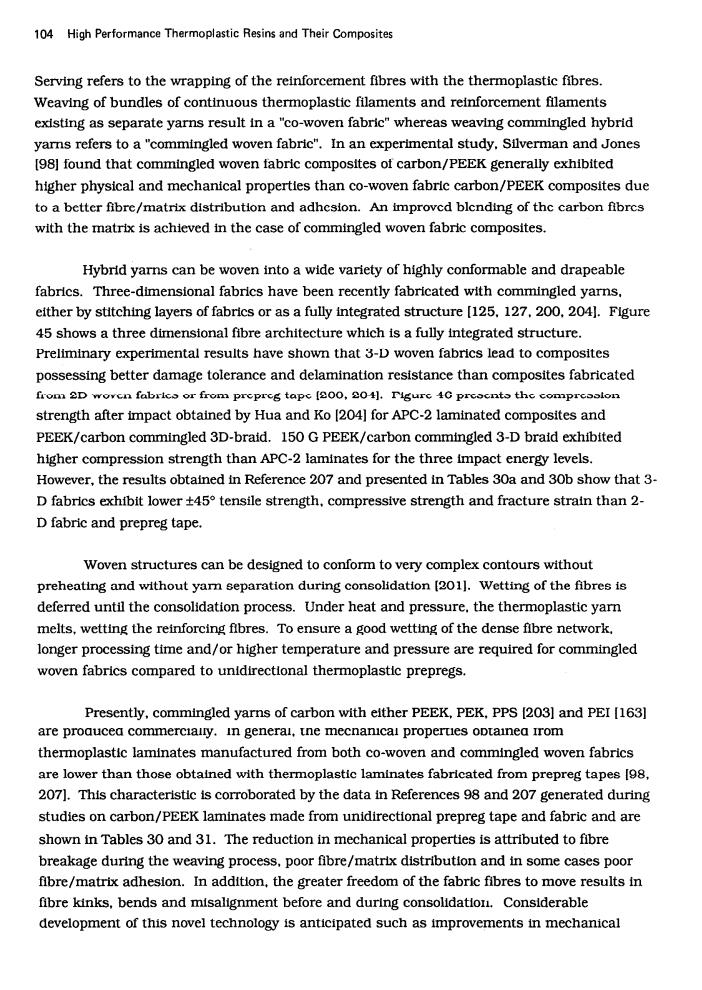正在加载图片...

104 High Performance Thermoplastic Resins and Their Composites Serving refers to the wrapping of the reinforcement fibres with the thermoplastic fibres. Weaving of bundles of continuous thermoplastic filaments and reinforcement filaments existing as separate yarns result in a "co-woven fabric"whereas weaving commingled hybrid yarns refers to a "commingled woven fabric".In an experimental study.Silverman and Jones [98]found that commingled woven fabric composites of carbon/PEEK generally exhibited higher physical and mechanical properties than co-woven fabric carbon/PEEK composites due to a better fibre/matrix distribution and adhesion.An improvcd blcnding of thc carbon fbrcs with the matrix is achieved in the case of commingled woven fabric composites. Hybrid yarns can be woven into a wide variety of highly conformable and drapeable fabrics.Three-dimensional fabrics have been recently fabricated with commingled yarns, either by stitching layers of fabrics or as a fully integrated structure [125.127.200.204].Flgure 45 shows a three dimensional fibre architecture which is a fully integrated structure. Preliminary experimental results have shown that 3-D woven fabrics lead to composites possessing better damage tolerance and delamination resistance than composites fabricated from 2D woven fabrics or from prepreg tapc (200,2041.rigurc 4G prcocnto the comprcoolon strength after impact obtained by Hua and Ko [204]for APC-2 laminated composites and PEEK/carbon commingled 3D-braid.150 G PEEK/carbon commingled 3-D braid exhibited higher compression strength than APC-2 laminates for the three impact energy levels. However,the results obtained in Reference 207 and presented in Tables 30a and 30b show that 3. D fabrics exhibit lower t45 tensile strength,compressive strength and fracture strain than 2- D fabric and prepreg tape. Woven structures can be designed to conform to very complex contours without preheating and without yarn separation during consolidation [201].Wetting of the fibres is deferred until the consolidation process.Under heat and pressure.the thermoplastic yarn melts,wetting the reinforcing fbres.To ensure a good wetting of the dense fbre network, longer processing time and/or higher temperature and pressure are required for commingled woven fabrics compared to unidirectional thermoplastic prepregs. Presently,commingled yarns of carbon with either PEEK,PEK,PPS [203]and PEI[163] are proaucea commercialry.in general,tne mecnanical properuies optainea irom thermoplastic laminates manufactured from both co-woven and commingled woven fabrics are lower than those obtained with thermoplastic laminates fabricated from prepreg tapes [98, 207].This characteristic is corroborated by the data in References 98 and 207 generated during studies on carbon/PEEK laminates made from unidirectional prepreg tape and fabric and are shown in Tables 30 and 31.The reduction in mechanical properties is attributed to fibre breakage during the weaving process,poor fibre/matrix distribution and in some cases poor fibre/matrix adhesion.In addition,the greater freedom of the fabric fibres to move results in fibre kinks,bends and misalignment before and during consolidation.Conslderable development of this novel technology is anticipated such as improvements in mechanical104 High Performance Thermoplastic Resins and Their Composites Serving refers to the wrapping of the reinforcement fibres with the thermoplastic fibres. Weaving of bundles of continuous thermoplastic filaments and reinforcement filaments existing as separate yarns result in a “co-woven fabric” whereas weaving commingled hybrid yarns refers to a “commingled woven fabric”. In an experimental study, Silverman and Jones [98] found that commingled woven fabric composites of carbon/PEEK generally exhibited higher physical and mechanical properties than co-woven fabrie carbon/PEEK composites due to a better fibre/matrix distribution and adhesion. An improved blending of the carbon fibres with the matrix is achieved in the case of commingled woven fabric composites. Hybrid yarns can be woven into a wide variety of highly conformable and drapeable fabrics. Three-dimensional fabrics have been recently fabricated with commingled yams, either by stitching layers of fabrics or as a fully integrated structure [125, 127. 200, 2041. Figure 45 shows a three dimensional fibre architecture which is a fully integrated structure. Preliminary experimental results have shown that 3-D woven fabrics lead to composites possessing better damage tolerance and delamination resistance than composites fabricated from 2D woven fabrics or from prepreg tape [200,204]. Figure 46 presents the compression strength after impact obtained by Hua and Ko [204] for APC-2 laminated composites and PEEK/carbon commingled 3D-braid. 150 G PEEK/carbon commingled 3-D braid exhibited higher compression strength than APC-2 laminates for the three impact energy levels. However. the results obtained in Reference 207 and presented in Tables 30a and 30b show that 3- D fabrics exhibit lower i45’ tensile strength, compressive strength and fracture strain than 2- D fabric and prepreg tape. Woven structures can be designed to conform to very complex contours without preheating and without yam separation during consolidation [201]. Wetting of the flbres is deferred until the consolidation process. Under heat and pressure, the thermoplastic yam melts, wetting the reinforcing fibres. To ensure a good wetting of the dense fibre network, longer processing time and/or higher temperature and pressure are required for commingled woven fabrics compared to unidirectional thermoplastic prepregs. Presently, commingled yarns of carbon with either PEEK, PEK, PPS ]203] and PEI [ 1631 are produced commercially. In general, the mechanical properties obtained from thermoplastic laminates manufactured from both co-woven and commingled woven fabrics are lower than those obtained with thermoplastic laminates fabricated from prepreg tapes 198, 2071. This characteristic is corroborated by the data in References 98 and 207 generated during studies on carbon/PEEK laminates made from unidirectional prepreg tape and fabric and are shown in Tables 30 and 3 1. The reduction in mechanical properties is attributed to fibre breakage during the weaving process, poor fibre/matrix distribution and in some cases poor flbre/matrix adhesion. In addition. the greater freedom of the fabric fibres to move results in fibre kinks, bends and misalignment before and during consolidation. Considerable development of this novel technology is anticipated such as improvements in mechanical